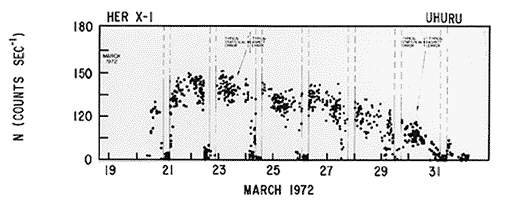Uhuru observations of Hercules X-1This light curve of Her X-1 shows long term and medium term variability. Each pair of vertical lines deliniate the eclipse of the compact object behind its companion star. In this case, the companion is a 2 Solar-mass star with a radius of nearly 4 times that of our Sun. This eclipse shows us the orbital period of the system, 1.7 days. The long term variability shown here is precession of a disk of accreting matter around the neutron star. This precession has a 35-day period. In addition, the neutron star in Her X-1 is also a pulsar with a 1.24 second pulse period.
IMAGES |
By Mission |
Stars |
HEASARC Home | Observatories | Archive | Calibration | Software | Tools | Students/Teachers/Public Last modified: Thursday, 26-Jun-2003 13:48:45 EDT |


